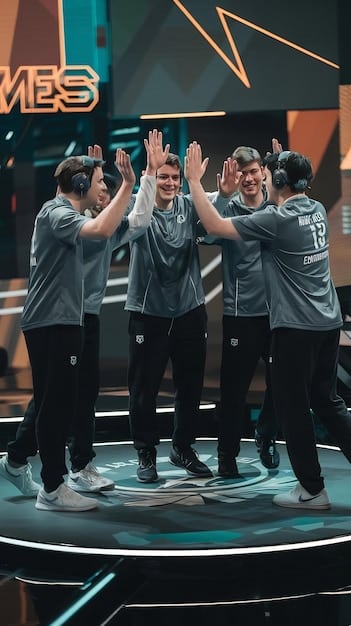Esports Community Building: Proven Strategies for US Fanbase Growth

Esports community building in the US is achieved through strategies such as consistent engagement, leveraging social media, hosting events, and fostering inclusive environments, all aimed at cultivating a loyal and active fanbase.
Building a thriving esports community in the US requires a strategic approach. It’s more than just playing games; it’s about fostering connections and creating a sense of belonging. Let’s explore effective strategies for esports community building in the US: strategies for growing your fanbase.
Understanding the Esports Landscape in the US
The esports landscape in the US is dynamic and competitive. Understanding its nuances is crucial for successful community building. So, what makes the US esports scene unique?
The US esports market encompasses a wide range of games and demographics. From collegiate leagues to professional tournaments, the opportunities are vast and varied. Understanding these diverse segments allows for targeted community-building efforts.
The Role of Regional Differences
Esports enthusiasm varies across different regions in the US. Tailoring your approach to local preferences can significantly impact community growth. What works in California might not resonate in New York.
Key Esports Titles and Their Communities
Certain games dominate the US esports scene. Knowing which titles have the largest and most engaged communities is key. For instance, games like League of Legends, Counter-Strike, and Overwatch boast significant followings.
- League of Legends (LoL): Popular for its strategic gameplay and competitive scene.
- Counter-Strike: Global Offensive (CS:GO): A classic FPS with a dedicated community.
- Overwatch: Known for its team-based action and vibrant esports league.
- Fortnite: Appeals to a younger demographic with its battle royale format.
Therefore, grasping the intricacies of the US esports scene lays the foundation for effective and targeted community-building strategies.

Defining Your Esports Community
Before diving into tactics, it’s essential to define what your esports community represents. What are your goals and values? Understanding these core aspects will shape your strategy.
Defining your community starts with identifying your target audience. Are you focusing on casual players, competitive gamers, or a mix of both? Tailoring your content and activities to their interests is paramount.
Identifying Your Target Audience
Understanding the demographics and preferences of your target audience is vital. This includes factors such as age, gaming preferences, and online behavior. Use surveys and social media analytics to gather insights.
Establishing Core Values and Culture
A strong community is built on shared values and a positive culture. Define principles like respect, inclusivity, and sportsmanship to guide interactions. These values will help attract like-minded members.
- Inclusivity: Ensure everyone feels welcome and valued, regardless of skill level or background.
- Respect: Promote respectful communication and discourage toxicity.
- Sportsmanship: Encourage fair play and graciousness in victory and defeat.
- Engagement: Foster active participation and interaction among community members.
Consequently, a clear definition of what your community stands for will attract the right members and foster a strong sense of belonging.
Utilizing Social Media Platforms
Social media is a powerful tool for esports community engagement. Strategic use of platforms can significantly boost your fanbase. Which platforms are most effective?
Platforms like Twitter, Twitch, and Discord offer unique opportunities for reaching and engaging with esports enthusiasts. Each platform has its strengths and caters to different audiences. Choose platforms where your target audience is active.
Best Practices for Twitter Engagement
Twitter is ideal for sharing quick updates, engaging in real-time conversations, and running polls. Use relevant hashtags to increase visibility and interact with followers.
Maximizing Twitch for Live Streaming
Twitch is the go-to platform for live streaming esports content. Consistent streaming, interactive gameplay, and engaging commentary can attract viewers and build a loyal following.
- Consistent Schedule: Establish a regular streaming schedule to build anticipation.
- Interactive Content: Engage with viewers through chat and interactive gameplay.
- Promote Streams: Use social media to promote upcoming streams.
- Collaborate: Partner with other streamers to expand your reach.
Therefore, leveraging social media effectively can dramatically expand your reach and deepen engagement with your esports community.
Hosting Engaging Online Events
Online events are crucial for maintaining community engagement. They provide opportunities for interaction and foster a sense of togetherness. So, what types of online events work best?
From tournaments to watch parties, online events offer various ways to bring your community together. These events can cater to different interests and skill levels, ensuring inclusivity and participation.

Organizing Online Tournaments
Tournaments provide a competitive outlet for community members. Use platforms like Battlefy or Toornament to manage brackets and facilitate matches. Consider offering prizes to incentivize participation.
Creating Interactive Watch Parties
Watch parties are a great way to enjoy esports events together. Use Discord or other platforms to stream games and chat with viewers in real-time. Add interactive elements like polls and quizzes to keep viewers engaged.
- Promote Events: Share event details on social media and community forums.
- Provide Commentary: Offer insightful commentary during watch parties.
- Engage Viewers: Encourage viewers to participate in chat and polls.
- Offer Prizes: Give away prizes to incentivize participation.
Hosting regular and engaging online events can significantly boost community participation and camaraderie.
Fostering a Positive and Inclusive Environment
A positive and inclusive environment is vital for long-term community success. It ensures that everyone feels welcome and valued. How do you create such an environment?
Creating a welcoming atmosphere requires active moderation and clear guidelines. Addressing toxicity and promoting respectful communication are essential components. Lead by example and encourage positive behavior.
Implementing Community Guidelines
Establish clear rules of conduct and enforce them consistently. These guidelines should address issues like harassment, discrimination, and spam. Make them easily accessible on your community platforms.
Promoting Diversity and Inclusion
Actively promote diversity and inclusion within your community. Celebrate different backgrounds and perspectives. Provide opportunities for underrepresented groups to share their voices.
- Representation: Feature diverse members in community content.
- Accessibility: Ensure your community is accessible to people with disabilities.
- Feedback: Solicit feedback from community members on inclusivity.
- Moderation: Actively moderate against discriminatory behavior.
A positive and inclusive environment will attract a wider audience and foster a stronger sense of loyalty and belonging.
Measuring and Adapting Your Strategies
Measuring your community-building efforts is crucial for continuous improvement. Track key metrics and adapt your strategies based on the data. What metrics should you monitor?
Monitoring metrics like membership growth, engagement rates, and social media reach provides valuable insights. Use analytics tools to track these metrics and identify areas for improvement. Regularly evaluate your strategies and make adjustments as needed.
Tracking Key Performance Indicators (KPIs)
Identify KPIs that align with your community goals. These might include the number of active members, the frequency of interactions, or the reach of your social media campaigns. Use tools like Google Analytics and social media analytics dashboards to track these KPIs.
Gathering Feedback from Community Members
Solicit feedback from community members through surveys, polls, and direct communication. Understand their needs and preferences. Use this feedback to improve your content, events, and overall community experience.
- Surveys: Conduct regular surveys to gather quantitative data.
- Feedback Forms: Provide feedback forms on your website and social media channels.
- Community Forums: Monitor discussions on community forums for insights.
- Direct Communication: Encourage members to share their thoughts and suggestions.
By continuously measuring and adapting your strategies, you can optimize your community-building efforts and achieve your goals.
| Key Point | Brief Description |
|---|---|
| 🎯Target Audience | Identify and cater to specific gamer demographics for relevance. |
| 📢Social Media | Leverage platforms like Twitch and Twitter for broad community outreach. |
| 🎮Online Events | Host tournaments and watch parties to boost engagement. |
| 👍Positive Env. | Cultivate inclusivity and respect to build loyalty. |
Frequently Asked Questions (FAQ)
▼
The first step is defining your community’s focus and goals. Target a specific game or genre and identify your ideal member profile to tailor your efforts effectively.
▼
Social media is extremely important. Platforms like Twitch, Twitter, and Discord are essential tools for reaching, engaging, and growing your esports community.
▼
Host a mix of tournaments, watch parties, and casual game nights. Varying events keeps the community active and engaged, catering to different interests and skill levels.
▼
Establish clear community guidelines promoting respect and inclusivity. Actively moderate discussions and celebrate diversity within your community to foster a welcoming environment.
▼
Track metrics like membership growth, engagement rates, and social media reach. Gather feedback through surveys and polls to continuously improve your strategies and better serve your members.
Conclusion
Building a successful esports community in the US involves a blend of strategic planning, consistent engagement, and a commitment to creating a positive and inclusive environment. By understanding the esports landscape, leveraging social media, hosting engaging events, and continuously adapting your strategies, you can cultivate a loyal and active fanbase that thrives.





